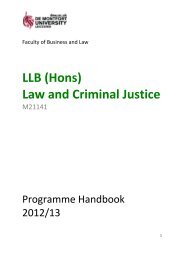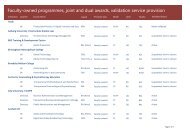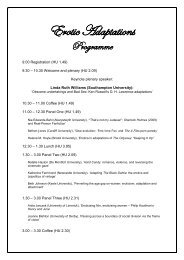Evaluation of the Crash Course March 2009 - De Montfort University
Evaluation of the Crash Course March 2009 - De Montfort University
Evaluation of the Crash Course March 2009 - De Montfort University
Create successful ePaper yourself
Turn your PDF publications into a flip-book with our unique Google optimized e-Paper software.
(McKenna, 2006.) He also draws attention to <strong>the</strong> persistence <strong>of</strong> <strong>the</strong> ‘it won’t happen<br />
to me’ syndrome <strong>of</strong> unrealistic optimism and illusions <strong>of</strong> control even in <strong>the</strong> face <strong>of</strong><br />
advice about risk reduction (McKenna, 1993).<br />
The message from <strong>the</strong>se studies seems quite clear: deterrence-oriented attitude<br />
change programmes relying on shocking messages are not always effective in<br />
changing young people’s behaviour and <strong>the</strong>y may actually have harmful effects.<br />
However, a substantial amount <strong>of</strong> psychological research has demonstrated that in<br />
certain circumstances, certain types <strong>of</strong> fear-based appeals can be successful in<br />
changing people’s attitudes and behaviour (Witte and Allen, 2000; Windell and Allen,<br />
2005; Meyerowitz and Chaiken, 1987).<br />
Early psychological research on health education also showed that attempts to<br />
change attitudes using shocking messages can sometimes be problematic (e.g.<br />
Liberman and Chaiken, 1992; Petty, 1995). Where <strong>the</strong> attempt to change attitudes<br />
shocks people into feeling fear or o<strong>the</strong>r strong emotional responses and <strong>the</strong> person<br />
being persuaded does not clearly perceive a way in which <strong>the</strong>ir future actions can<br />
moderate <strong>the</strong>se feelings, poor results in attitude change can follow as people<br />
disengage from <strong>the</strong> communication and do not rationally process <strong>the</strong> information<br />
<strong>the</strong>y receive (e.g. Jepson and Chaiken, 1990; Liberman and Chaiken, 1992).<br />
Windell and Allen (2005) provide an examination <strong>of</strong> <strong>the</strong> literature on fear appeals and<br />
consider <strong>the</strong> lessons for behaviour-changing programmes aimed at young people in<br />
terms <strong>of</strong> what <strong>the</strong>y tend to do wrong and how <strong>the</strong>y might better align <strong>the</strong>mselves with<br />
an evidence-based approach to changing attitudes and behaviours.<br />
One important issue is <strong>the</strong> level <strong>of</strong> fear invoked. If perceived threat caused by <strong>the</strong><br />
use <strong>of</strong> fear-based messages is too low, “<strong>the</strong> individual does no fur<strong>the</strong>r cognitive<br />
processing <strong>of</strong> <strong>the</strong> fear because <strong>of</strong> a lack <strong>of</strong> motivation” (Windell and Allen, 2005;<br />
p.389). Correspondingly, however, if <strong>the</strong> perceived level <strong>of</strong> threat is high but <strong>the</strong><br />
individual does not believe that <strong>the</strong>re is an effective way for him or her to take some<br />
action that will diminish this threat <strong>the</strong>n it is more likely he or she will “become<br />
defensive or deny that <strong>the</strong> threat is real or that it applies to him or her” (Windell and<br />
Allen, 2005; p.389).<br />
What is needed for a fear-based appeal to succeed is its being accompanied by an<br />
appropriate recommended course <strong>of</strong> action that has <strong>the</strong> clear potential to counter <strong>the</strong><br />
threat raised in <strong>the</strong> fear-appeal. The individual receiving <strong>the</strong> fear-based appeal must<br />
also perceive <strong>the</strong> recommended action as achievable and effective. Windell and<br />
Allen (2005) provide a summary <strong>of</strong> overall recommendations for fear-inducing<br />
attitude-change messages. They argue that fear-based appeals will be most<br />
effective when:<br />
• They genuinely frighten people<br />
• They <strong>of</strong>fer specific recommendations for overcoming <strong>the</strong> fear-aroused threat<br />
• The recommended action is perceived by <strong>the</strong> recipient as potentially effective<br />
for reducing <strong>the</strong> threat, and<br />
• The recipient believes that <strong>the</strong>y can perform <strong>the</strong> recommended action<br />
26














